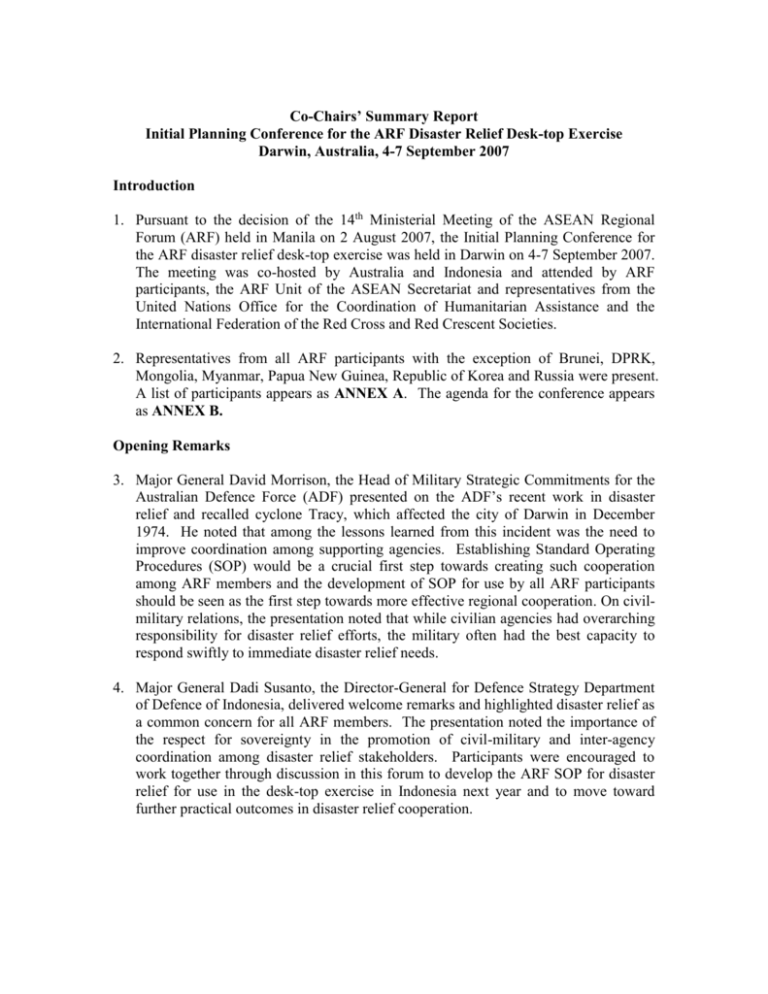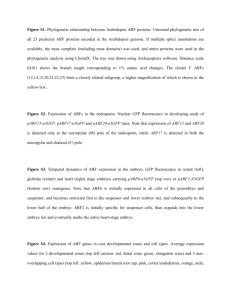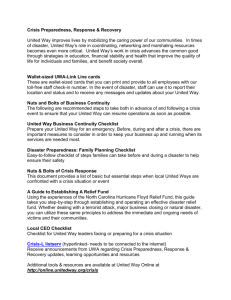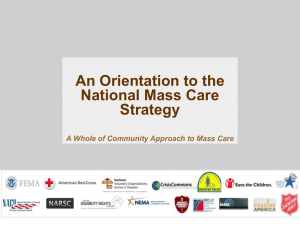ARF Table Top Exercise on Disaster Relief Initial Planning
advertisement

Co-Chairs’ Summary Report Initial Planning Conference for the ARF Disaster Relief Desk-top Exercise Darwin, Australia, 4-7 September 2007 Introduction 1. Pursuant to the decision of the 14th Ministerial Meeting of the ASEAN Regional Forum (ARF) held in Manila on 2 August 2007, the Initial Planning Conference for the ARF disaster relief desk-top exercise was held in Darwin on 4-7 September 2007. The meeting was co-hosted by Australia and Indonesia and attended by ARF participants, the ARF Unit of the ASEAN Secretariat and representatives from the United Nations Office for the Coordination of Humanitarian Assistance and the International Federation of the Red Cross and Red Crescent Societies. 2. Representatives from all ARF participants with the exception of Brunei, DPRK, Mongolia, Myanmar, Papua New Guinea, Republic of Korea and Russia were present. A list of participants appears as ANNEX A. The agenda for the conference appears as ANNEX B. Opening Remarks 3. Major General David Morrison, the Head of Military Strategic Commitments for the Australian Defence Force (ADF) presented on the ADF’s recent work in disaster relief and recalled cyclone Tracy, which affected the city of Darwin in December 1974. He noted that among the lessons learned from this incident was the need to improve coordination among supporting agencies. Establishing Standard Operating Procedures (SOP) would be a crucial first step towards creating such cooperation among ARF members and the development of SOP for use by all ARF participants should be seen as the first step towards more effective regional cooperation. On civilmilitary relations, the presentation noted that while civilian agencies had overarching responsibility for disaster relief efforts, the military often had the best capacity to respond swiftly to immediate disaster relief needs. 4. Major General Dadi Susanto, the Director-General for Defence Strategy Department of Defence of Indonesia, delivered welcome remarks and highlighted disaster relief as a common concern for all ARF members. The presentation noted the importance of the respect for sovereignty in the promotion of civil-military and inter-agency coordination among disaster relief stakeholders. Participants were encouraged to work together through discussion in this forum to develop the ARF SOP for disaster relief for use in the desk-top exercise in Indonesia next year and to move toward further practical outcomes in disaster relief cooperation. Presentations by AusAID and Emergency Management Australia (EMA) and the Royal Darwin Hospital 5. Mr Garry Dunbar, Director of Humanitarian and Emergency Section, AusAID, outlined the humanitarian principles of disaster relief, namely: humanity, impartiality, neutrality and independence from political, economic, military or other objectives. These were principles taken from the seven principles of the Red Cross and considered the foundation for humanitarian action undertaken by civilian actors. The presentation described the role of humanitarian agencies in emergency and disaster response operations and recognised that military assets were often involved. Based on the Oslo and UN Guidelines, the presentation noted that the military should be used as a last resort for disaster relief (noting however that the actual interpretation of the term ‘last resort’ varies). The presentation also discussed the role of UN agencies, such as OCHA, WFP, WHO, UNICEF, UNDP, UNHCR/IOM, as important civilian resources for disaster relief. The presentation noted that many of these civilian agencies, including NGOs, were developing common standards on aspects relating to participation, initial assessment, response, targeting, monitoring and evaluation. The presentation appears as ANNEX C. 6. Mr Greg Lovell, Director of Planning and Coordination, Emergency Management Australia (EMA), discussed Australia’s emergency management mechanisms at the national, municipal and local government levels. Emergency management was described as a partnership between all levels of government and the community including prevention, preparedness, response and recovery. The presentation also noted EMA’s partnership with Indonesia’s national disaster management agency, Bakornas, and the ongoing work between the two countries to strengthen emergency response and management systems. The presentation appears as ANNEX D. 7. Dr Malcolm Johnston-Leek from the Royal Darwin Hospital gave a presentation on the capabilities of the hospital including links with the Rumah Sakit Sanglah in Denpasar and Singapore General Hospital. The hospital’s national role in disaster response and preparedness was also discussed. The presentation appears as ANNEX E. Presentation by the United Nations Office for the Coordination of Humanitarian Affairs (OCHA) 8. Mr Tony Craig, representing the United Nations Office for the Coordination of Humanitarian Affairs, provided an overview of the role of the UN in emergency relief coordination and outlined elements of the international response to humanitarian emergencies including OCHA and the World Food Programme. OCHA raised the issue of competition among international humanitarian agencies. The presentation described a number of key UN and international actors with different roles and the links between these actors. OCHA’s civil-military coordination contacts were also outlined. The speaker noted that from the perspective of OCHA, there was a need to avoid a proliferation of standardised procedures. However the ARF SOP were viewed as compatible with UN and other guidance and therefore could be a useful contribution. The presentation appears as ANNEX F. Presentation by the International Federation of the Red Cross and Red Crescent Societies (IFRC) 9. Ms Victoria Bannon, IDRL Programme Coordinator (Asia Pacific) for the International Federation of the Red Cross and Red Crescent Societies, gave an overview of the Red Cross and Red Crescent movement including: the history, structure and function of the International Committee of the Red Cross (ICRC), National Red Cross and Red Crescent Societies (National Societies) and the International Federation of Red Cross and Red Crescent Societies (IFRC). An outline of the primary documents used by the IFRC to determine relationships with the military was also given. The presentation included a briefing on the International Disaster Response Laws, rules and principles (IDRL), its aims and mandate, common legal issues in international disaster response and an overview of the international legal framework. The presentation appears as ANNEX G. Presentation on the Desk-top Exercise 10. Australia and Indonesia presented a preliminary concept and possible scenario for the ARF disaster relief desktop exercise to be held at the Navy Command and Staff College SESKO-AL in Jakarta, mooted for April 2008. It was agreed that Australia and Indonesia would further discuss possible scenarios for the desktop exercise focusing on usefully testing the SOPs and taking into account suggestions and comments of ARF participants. Further updates to the draft scenario will be provided in forthcoming ARF inter-sessional meetings. A preliminary exercise schedule for the desktop exercise appears as ANNEX H. Syndicate Discussion on the Draft SOP 11. The Meeting was divided into three syndicate groups to discuss the draft SOP. The three syndicates agreed that the current draft ARF SOP would benefit from being refined over time to ensure the best possible application among ARF members. The meeting agreed that the ARF SOP should complement internationally agreed principles in military-to-military and civil-military cooperation. The meeting noted the importance of existing mechanisms such as the ARF General Guidelines on Disaster Management and the ASEAN SOP for Regional Standby Arrangements and Coordination of Joint Disaster Relief and Emergency Response Operation (SASOP), currently in draft form. 12. The syndicate groups discussed the following important elements to be incorporated in, and accompany, the ARF SOP: a. The principles of how to improve coordination to reduce response time. b. It was agreed that the ARF SOP would be of most value if applied to the first stages of the disaster management cycle (focusing on the immediate response aspects and to a lesser extent on the earlier ‘preparedness’ element). Participants also agreed that the ARF SOP should focus on the strategic rather than tactical level and be designed to enhance and simplify multilateral cooperation and coordination between the affected nation/s and other ARF members. c. The ARF SOP should take into account relevant aspects of existing disaster relief guidelines and SOPs such as the draft IFRC IDRL and the draft SASOP. d. Participants discussed the need for an ARF coordination structure and/or centre. Among the options raised was the possibility of the ARF using existing disaster relief coordination mechanisms such as the ASEAN Center for Humanitarian Assistance (AHA Center) and the UNOCHA coordination body. The meeting stressed that ARF members would have the option to utilise both bilateral and multilateral channels through the ARF coordination mechanism. The SOP could include in its annex the terms of reference on the utilisation of the ARF disaster relief coordination centre if such a centre is established. Furthermore, the meeting acknowledged that for multilateral cooperation to work efficiently adequate bilateral agreements and arrangements amongst ARF members needed to be in place. e. The need to develop a database with the information including a list of ARF experts on disaster relief and their areas of expertise, national points of contact, and resources and regional capacities for ARF participants. f. Future ARF disaster relief training should include workshops or other ARF activities focused on improving coordination and the exchange of information among ARF participants. g. The ARF SOP should incorporate as annexes existing documents used in the disaster relief context in regional and international levels. h. Attaching a template MOU as an annex may also assist ARF members in ascertaining essential issues that need to be addressed to enable quicker assistance in the case of a disaster. i. The ARF SOP should emphasise the military as a supporting component in disaster relief efforts rather than the lead agency. j. Participants suggested that a flow-chart illustrating the different phases of disaster relief may be a useful addition to the SOP. Practical Demonstration of Disaster Relief Response Assets 13. The Conference participants attended a practical demonstration of disaster relief response assets provided by 1 Brigade's 1st Combat Engineer Regiment (1 CER). The practical display included types of equipment and capabilities held within 1 CER and other units of the Brigade applicable to the provision of assistance to emergency services locally and internationally as and if required. Capabilities on display included light, medium and heavy wheeled and tracked plant, water purification equipment, expedient bridging, search capabilities, army working divers, explosive ordnance disposal, chemical decontamination and fire fighting appliances. Other Matters 14. Australia briefed the Meeting on the proposed schedule for the development of the ARF SOP. ARF members are encouraged to submit further comments on the draft SOP by the end of October 2007. The revised draft ARF SOP will be prepared in February 2008 for use in the desk-top exercise.








